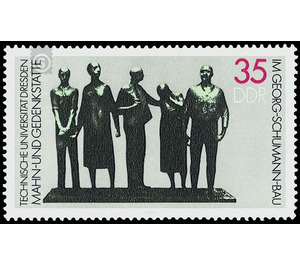Commemorative stamp series - Germany / German Democratic Republic 1984 - 35 Pfennig
Theme: Architecture
| Country | Germany / German Democratic Republic |
| Issue Date | 1984 |
| Face Value | 35.00 |
| Color | grey |
| Perforation | K 14 |
| Printing Type | Rotogravure 2 |
| Stamp Type | Postage stamp |
| Item Type | Stamp |
| Chronological Issue Number | 2639 |
| Chronological Chapter | GER-DDR |
| Michel ID | DDR 2897 |
| SID | 774999 |
| In 19 Wishlists | |
Remembrance and memorial in the Georg Schumann building of the Technical University in Dresden With a picture from the memorial and memorial in the Georg Schumann building of the Technical University of Dresden, the Ministry of Posts and Telecommunications of the German Democratic Republic issued a multicolored special postage stamp , Memorial from 18 September to 17 November Remembrance and memorial in the Georg Schumann Building in Dresden In the twelve years of fascist reign of terror, the district court in Dresden on Munich Square (now Salvador Allende Square) became one of the most notorious strongholds of the fascist Blood justice and an extermination site of many hundreds of anti-fascists, communists, social democrats and other opponents of Hitler from eleven nations. In addition to German antifascists, Belgians, Bulgarians, Frenchmen, Yugoslavs, Austrians, Poles, Swiss, Soviet citizens, Czechoslovaks and Hungarians, including 46 women and girls, fell victim to the executioner's ax in the Dresden district court. The overwhelming majority of anti-fascists murdered in Dresden were Czechoslovak resistance fighters and patriots. One of the outstanding fighters against fascist barbarism, the cause of the working class and the entire working people was the indomitable communist Georg Schumann, after whom today the building complex with the memorial and memorial is named. He was head of a Leipzig resistance group. "I was born a socialist and I've lived and fought as a socialist, my comrades and I are in the dock today, and you're giving us the death sentence, time is not far off where you're sitting in the dock and moaning about your life." , Georg Schumann called the fascist judiciary murderers of the "People's Court" in his closing words. After the destruction of Hitler's fascism by the Soviet army, this site of fascist murder justice was liquidated just like the entire fascist power apparatus. The extensive building complex of the former district court could be supplied to a humanistic use. In 1957 he was handed over by the Government of the GDR to the Technical University of Dresden. The former fortress of fascist terror became a place of science and progress. In 1958, encouraged by the party of the working class, the student youth proposed to transform the Richthof and the death cells of the former fascist regional court into a worthy memorial. The young students proved to be true heirs of the revolutionary traditions of the working class and the anti-fascist resistance movement. In addition to more than 10,000 voluntary working hours, which they carried out together with workers Dresden companies and with scientists, they raised more than 30,000 marks for the establishment and design of the memorial. The sculptor Arno Wittig created the group sculpture "Resistance fighters", which was set up in the former execution court. With the establishment of this memorial - its inauguration took place on 11 October 1959 - both the 1069 anti-fascist resistance fighters, who were executed by the Hitlerite fascists after 1933, and the fighters of the workers' movement, who were incarcerated here in earlier years, honored. Every year, the memorial and memorial in the Georg Schumann Building of the Technical University of Dresden is visited by hundreds of thousands from Germany and abroad. None of the visitors can escape the profound, lasting impression of the immediate confrontation of past and present: the bloody and misanthropic past with the blood justice of the district court and its execution court, reminiscent of the steadfastness and certainty of victory of the antifascist fighters and the palpable present , the peaceful life and scientific research in the same building complex.
| Condition | Name | In Stock | Price | Price + Shipping | Store | |
|---|---|---|---|---|---|---|
 | Unmounted Mint ** | Commemorative stamp series - Germany / German Democratic Republic 1984 - 35 Pfennig | 7 | US $0.484 | US $3.70 |  FILATELIELOKET (0) FILATELIELOKET (0)Shipping US $3.22 Minimum Order US $2.69 |


